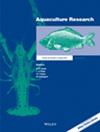孟加拉国不同养殖制度下黑虎对虾的细菌多样性和抗生素抗性基因
IF 1.9
4区 农林科学
Q2 FISHERIES
引用次数: 0
摘要
斑节对虾(Penaeus monodon)肠道及其周围环境(如水和沉积物)中的微生物群落被认为是虾可持续养殖的关键因素。由于抗生素耐药性细菌(ARB),特别是抗生素耐药性基因(ARGs)的出现,抗生素在水产养殖中的滥用越来越受到关注。本研究调查了四种不同对虾养殖系统的微生物组组成和19种ARGs;(i) 集群,(ii)广泛,(iii)半密集,和(iv)在孟加拉国西南沿海地区广泛改善。为此,该研究应用了先进的基于16S rRNA的宏基因组测序来研究细菌组成。此外,采用基因特异性聚合酶链式反应(PCR)检测不同养殖系统的虾、水和沉积物中的ARGs。在目前的研究中,来自变形杆菌门和厚壁菌门的细菌在样本中占主导地位(n = 12) 从不同的农业系统收集,其次是放线菌、拟杆菌和蓝藻。厚壁菌门是集群(相对丰度53.33%)和半密集(相对丰度59.2%)培养系统中培养的虾肠道中的主要门。结果表明,肠道、沉积物、水样以及农业系统中的细菌群落结构有显著差异(p<0.05)。沉积物样本(16495)中的共享操作分类单元(OTU)几乎是肠道(7931)和水(8513)细菌群落的两倍。改良的粗放型农业系统显示,1289个(11.05%)的OTU在肠道、沉积物和水中共享,其次是半集约型(6.87%)、集群型(6.27%)和粗放型(5.46%)农业系统。在测试的ARGs中,sul1、cat、gyrA(C)、tetA、tetC、tetX、ere(A)、vanR和dfrA1在水和沉积物样品中占主导地位。半集约农业系统的ARGs患病率最高(21.05%),而粗放农业系统的发病率最低(5.26%)。总的来说,这项研究提供了孟加拉国对虾养殖中细菌组成和ARGs生长的综合情况。因此,生产策略必须关注抗生素的替代品,以使对虾养殖技术更具可持续性。本文章由计算机程序翻译,如有差异,请以英文原文为准。
Bacterial Diversity and Antibiotic Resistance Genes Associated with the Different Farming Systems of Black Tiger Shrimp (Penaeus monodon) in Bangladesh
Microbial community inhabiting the intestine of the shrimp (Penaeus monodon) and their surrounding environments (e.g., water and sediment) is considered as a key contributing factor for the sustainable farming of shrimp. Indiscriminate application of antibiotics in aquaculture is a growing concern due to the emergence of antibiotic resistant bacteria (ARB), more specifically the antibiotic resistance genes (ARGs). The present study investigates the microbiome composition and 19 ARGs from four different shrimp farming systems; (i) cluster, (ii) extensive, (iii) semi-intensive, and (iv) improved extensive in the southwest coastal region of Bangladesh. In doing so, the study applied advanced 16S rRNA-based metagenomic sequencing to study the bacterial composition. Moreover, gene specific polymerase chain reaction (PCR) was employed to detect the ARGs in shrimp, water, and sediments of different farming systems. In the current study, bacteria from the phylum Proteobacteria and Firmicutes were predominant among the samples (n = 12) collected from the different farming systems followed by Actinobacteria, Bacteroidetes, and Cyanobacteria. Firmicutes was the predominant phylum in the gut of shrimp cultured in the cluster (relative abundance 53.33%) and semi-intensive (relative abundance 59.2%) culture systems. Results indicated that the bacterial community structure was significantly (
p
<
0.05
) distinct among gut, sediment, and water samples as well as the farming systems. The shared operational taxonomic unit (OTU) in the sediment sample (16,495) was nearly double than the gut (7,931) and water (8,513) bacterial communities. The improved extensive farming system showed 1,289 (11.05%) shared OTUs among gut, sediment, and water followed by semi-intensive (6.87%), cluster (6.27%), and extensive (5.46%) farming system. Among the tested ARGs, sul1, cat, gyrA(C), tetA, tetC, tetX, ere(A), vanR, and dfrA1 were predominant in water and sediment samples. Semi-intensive farming system had the highest prevalence of ARGs (21.05%) while the lowest prevalence was found in extensive (5.26%) farming system. Overall, the study provides a comprehensive scenario of bacterial composition and growing emergence of ARGs in shrimp farming of Bangladesh. Therefore, the production strategy must focus on the alternatives of antibiotic for shaping the shrimp cultivation technique more sustainable.
求助全文
通过发布文献求助,成功后即可免费获取论文全文。
去求助
来源期刊

Aquaculture Research
农林科学-渔业
CiteScore
4.60
自引率
5.00%
发文量
464
审稿时长
5.3 months
期刊介绍:
International in perspective, Aquaculture Research is published 12 times a year and specifically addresses research and reference needs of all working and studying within the many varied areas of aquaculture. The Journal regularly publishes papers on applied or scientific research relevant to freshwater, brackish, and marine aquaculture. It covers all aquatic organisms, floristic and faunistic, related directly or indirectly to human consumption. The journal also includes review articles, short communications and technical papers. Young scientists are particularly encouraged to submit short communications based on their own research.
 求助内容:
求助内容: 应助结果提醒方式:
应助结果提醒方式:


